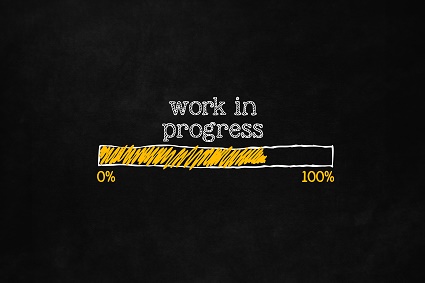Your cart is currently empty!

The Work in Progress Website
You need a website. You have a business or an organization that is doing things and needs to communicate with people, so a website is a must. You should get your domain as soon as possible, because a .com or .org is still the most valuable, and they’re going fast. The value of your domain increases over time, too, so you want to get online as quickly as possible. What’s more, you know that people will look for you online, and you want to be there so they don’t go to your competitors when they can’t find you.
However, you’re not quite ready. Your business plan is fluid, your product isn’t ready to ship, you haven’t yet found an office — there are lots of reasons that you might find yourself in this position.
Options for a work in progress website
When you’re in this position, though, you have several options.
- Wait until everything is settled. Go ahead and put up a “Coming Soon” page with contact information and get things settled behind the scenes. There are drawbacks to having a “Coming Soon” page up for months, but it’s a simple and practical solution if you’re expecting to have it there for days or even for a couple of weeks. What are the long term drawbacks? For one thing, it lessens trust. You look less on top of things as months stretch out and you’re still “coming soon.” For another, even if you ask search engines not to index your work in progress website, sometimes they do. In our experience, having a website coming soon for a long time often slows down indexing of the new site.
- Work in stages. Have your web firm create pages for the future and hide them. You know you want to have a staff page with photos and clever bios, but you don’t yet have a staff, let alone photos and clever bios? Create a staff page and hide it. We also often build websites with future e-commerce potential, so that when the client is ready to add e-commerce, we can get back in and create their e-commerce area in a cost-effective way, instead of needing to start over from the beginning. Make a contact page with a form, and add your office address later. The better your advance planning, the smoother the later changes will be.
- Build anticipation. If you are on your way but not quite ready, you can set up for an unveiling. The new product that is in production but not yet shipping can have a page that collects emails of visitors who’d like to be notified when it’s ready. The Book Appointments page can have “We will begin booking appointments online in February. In the meantime, please call our office…” The new book can have a page of advance reviews and a pre-order offer. Bear in mind, the page that says, “Check back often because we’ll be adding new information soon!” gets old fast if you don’t actually add things soon. The Build Anticipation approach should only be used when you have a realistic timeline and steps in place.
Just be sure to choose the option that will work best for your actual plans, rather than your most optimistic ones. If you’re going to offer products online sometime in the next few years, build your website in stages. If you’ll have everything checked off your list within the next week, a “Coming Soon” page makes sense. If you have definite plans, the Build Anticipation plan can pay off with buzz in social media and the press.
The worst choice is failing to launch your website until everything is completely settled. Websites grow stronger over time; if you wait for a couple of years to get all your ducks in a row before you launch, that’s years worth of missed opportunity.
by
Tags:

Leave a Reply